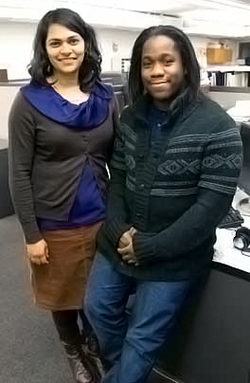Filed Under > Messages
Touched by Technology
Using new media can help court-involved youth see a bigger picture
Grown-ups often bemoan kids’ fascination with digital cameras, cell phones and other new media. Lalitha Vasudevan, Assistant Professor of Technology and Education at Teachers College, sees it as an opportunity. “I build on an ethos that there’s power in the arts and technology,” Vasudevan says.
Making videos, for example, is a means for exploration, communication and self-expression. Those activities can help young people who have clashed with school authorities or the law see themselves in other roles.
As part of a five-year ethnography, “Education In-Between,” and now in a project called “Re-imagining Futures,” Vasudevan has taught and studied educational programs about digital media that provide an alternative to incarceration in Rikers Island, New York City’s main jail complex. This year, she and her research team will again facilitate an arts-based digital media project in an after-school program that offers students ages 13 to 16 an alternative to detention.
“My goal is to help kids believe in themselves as people who can have multiple possible futures,” she says.
Students may not feel they belong in school if their curiosity hasn’t been nurtured there before, Vasudevan says. Many in alternative programs lack a high school diploma and arriving after a spell in jail, need time to develop, or reconnect with, their academic goals. The programs enable them to be at home with their families and earn youthful offender status.
Vasudevan has seen students’ initial hesitation and resistance soften when they realize that they can bring their history into the classroom—and that teachers won’t indict them for past actions. Technology can help, because often it’s been a key part of who students are and how they function. Of one young man who needed to play with his iPod in class, Vasudevan says, “It was like knitting, or his version of doodling.”
Beyond using digital technology to reach young people, Vasudevan says adults must recognize that being able to upload a photo and other forms of tech savvy are themselves a kind of literacy. In an article published in Digital Culture & Education in May, she cites the conclusion of the Digital Youth Project, funded by the MacArthur Foundation: when students use new media they develop “a range of social, intellectual, cultural and technical knowledge.”
In teaching video skills, Vasudevan and her research team led students to make a collection of short narrative music videos featuring songs they’d written themselves.
“It gave them a space to tell their own stories,” says TC doctoral student Kristine Rodriguez. “They opened up and shared their ideas.”
Last year, a group of students made a video called “Stay in School,” a topic they chose themselves from a group conversation. The students recorded the soundtrack and wrote and performed the lyrics, which advised:
Get the knowledge
Support your family
Get the education
Go to college
Get out of the hood
Get the skills you need
Not that the video idealized school. A shot of an actual security guard conveyed the lock-down atmosphere students often perceive at school. But there was also a walk across the Columbia University campus, into a sunset.
Eric Fernandez, one of Vasudevan’s former students who is now a member of the research team, is documenting this year’s project on a group research blog. Fernandez has completed a job-readiness and college-preparation program and is planning to go to college and perhaps, eventually, work as a youth counselor. “I know a lot of people who have the prison mentality—‘This is all I know, I might as well stay here,’” he says. “It’s a moment in life when they’re confused. But you can also say, I made a mistake, but I can still work.”
—Temma Ehrenfeld
Published Wednesday, Dec. 1, 2010
